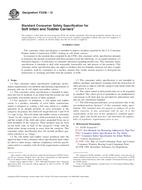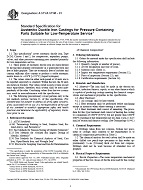1.1 This test method is used to provide predicted human skin burn injury for single layer garments or protective clothing ensembles mounted on a stationary instrumented manikin which are then exposed in a laboratory to a simulated fire environment having controlled heat flux, flame distribution, and duration. The average exposure heat flux is 84 kW/m² (2 cal/s•cm²), with durations up to 20 seconds.
1.2 The visual and physical changes to the single layer garment or protective clothing ensemble are recorded to aid in understanding the overall performance of the garment or protective ensemble and how the predicted human skin burn injury results can be interpreted.
1.3 The skin burn injury prediction is based on a limited number of experiments where the forearms of human subjects were exposed to elevated thermal conditions. This forearm information for skin burn injury is applied uniformly to the entire body except for the hands and feet. The hands and feet are not included in the skin burn injury prediction.
1.4 The measurements obtained and observations noted can only apply to the particular garment(s) or ensemble(s) tested using the specified heat flux, flame distribution, and duration.
1.5 This standard is used to measure and describe the response of materials, products, or assemblies to heat and flame under controlled conditions, but does not by itself incorporate all factors required for fire-hazard or fire risk assessment of the materials, products, or assemblies under actual fire conditions.
1.6 This method is not a fire-test-response test method.
1.7 The values stated in SI units are to be regarded as standard. The values given in parentheses are mathematical conversions to inch-pound units or other units commonly used for thermal testing. If appropriate, round the non-SI units for convenience.
1.8 This standard does not purport to address all of the safety concerns, if any, associated with its use. It is the responsibility of the user of this standard to establish appropriate safety and health practices and determine the applicability of regulatory limitations prior to use.
1.9 Fire testing is inherently hazardous. Adequate safeguards for personnel and property shall be employed in conducting these tests.
Product Details
- Published:
- 02/01/2011
- Number of Pages:
- 11
- File Size:
- 1 file , 230 KB
- Redline File Size:
- 2 files , 480 KB


